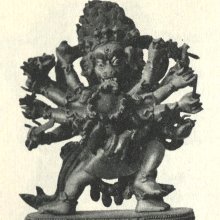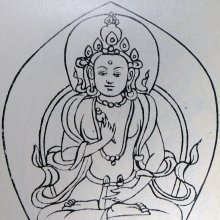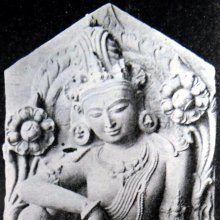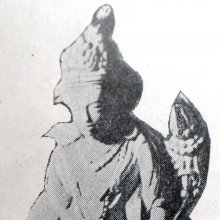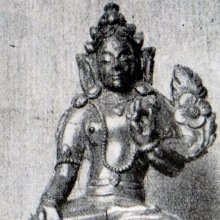Gandha, Gandhā, Gamdha: 55 definitions
Introduction:
Gandha means something in Buddhism, Pali, Hinduism, Sanskrit, Jainism, Prakrit, Marathi, Hindi, biology. If you want to know the exact meaning, history, etymology or English translation of this term then check out the descriptions on this page. Add your comment or reference to a book if you want to contribute to this summary article.
Images (photo gallery)
(+1 more images available)
In Hinduism
Ayurveda (science of life)
Nighantu (Synonyms and Characteristics of Drugs and technical terms)
Source: Wisdom Library: Raj NighantuGandha (गन्ध) refers to “fragrance” (viz., of a flower), as mentioned in a list of five synonyms, according to the second chapter (dharaṇyādi-varga) of the 13th-century Raj Nighantu or Rājanighaṇṭu (an Ayurvedic encyclopedia). The Dharaṇyādi-varga covers the lands, soil, mountains, jungles and vegetation’s relations between trees [viz., Gandha] and plants and substances, with their various kinds.
Agriculture (Krishi) and Vrikshayurveda (study of Plant life)
Source: Shodhganga: Drumavichitrikarnam—Plant mutagenesis in ancient IndiaGandha (गन्ध) refers to “fragrance (of plants/flowers)” which can be manipulated according to the bio-organic agricultural methods described in the Vṛkṣāyurveda by Sūrapāla (1000 CE): an encyclopedic work dealing with the study of trees and the principles of ancient Indian agriculture.—Accordingly, “Several special processes with reference to the plants will be described hereunder. They are: [e.g., producing fragrance (gandha-samutpatti); changing the fragrance (gandha-pravartana);] and so on. [...]”.
Unclassified Ayurveda definitions
Source: Wisdom Library: Āyurveda and botanyGandhā (गन्धा) is another name (synonym) for Śaṭī, which is a Sanskrit name for the plant Hedychium spicatum (spiked ginger lily). This synonym was identified by Narahari in his 13th-century Rājanighaṇṭu (verses 6.226-227), which is an Ayurvedic medicinal thesaurus.
Source: Tieteelliset verkkolehdet: A note on Sanskrit GandhaThere are nine kinds of scent (gandha), according to the Mahābhārata (12.177.28; Bhṛgu’s discourse):
- Agreeable (iṣṭa),
- Disagreeable (aniṣṭa),
- Sweet (madhu),
- Pungent (kaṭu),
- Stale (nirhārin),
- Compound (saṃhata),
- Soft (snigdha),
- Astringent (rūkṣa)
- and tender (viśada).
All these nine kinds of scent are founded upon the earth-element (pārthiva or pṛthivī).
Source: gurumukhi.ru: Ayurveda glossary of terms1) Gandha (गन्ध):—Smell
2) Smell : Odour

Āyurveda (आयुर्वेद, ayurveda) is a branch of Indian science dealing with medicine, herbalism, taxology, anatomy, surgery, alchemy and related topics. Traditional practice of Āyurveda in ancient India dates back to at least the first millenium BC. Literature is commonly written in Sanskrit using various poetic metres.
Shaivism (Shaiva philosophy)
Source: Wisdom Library: Kubjikāmata-tantraGandhā (त्वची, “Smell”):—Mentioned as a mātṛ in relation with Calanī, according to the Kubjikāmata-tantra. She is however, not usually part of the eight Mātṛs born from the body of Calanī. These eight sub-manifestations (mātṛ) symbolize a relation to the wind. They are presided over by the Bhairava Asitāṅga. Calanī is the fifth of the Eight Mahāmātṛs, residing within the Mātṛcakra (third of the five cakras) and represents wind.
Source: Wisdom Library: ŚaivismGandha (गन्ध) refers to the city of Vāyu, situated on the north-western lower slope of mount Meru, according to Parākhyatantra 5.66. Meru is the name of a golden mountained situated in the middle of nine landmasses (navakhaṇḍa): Bhārata, Hari, Kimpuruṣa, Ramyaka, Ramaṇa, Kuru, Bhadrāśva, Ketumāla and Ilāvṛta. Together these khaṇḍas make up the continent known as Jambūdvīpa.
Gandha is also known by the name Gandhavatī or Gandhavahā and is mentioned in various other sources, eg., the Svacchanda-tantra 10.132-136, Kiraṇa-āgama 8.51-54, Mṛgendra-āgama vidyāpāda 13.47-54, Sarvajñānottara-tantra adhvaprakaraṇa 34-36 and Mataṅga-āgama vidyāpāda 23.60-63
The Parākhyatantra is an old Śaiva-siddhānta tantra dating from before the 10th century.
Source: Shodhganga: Temple management in the ĀgamasGandha (गन्ध) or Vilepana refers to “fragrant sandal paste” and represents one of the various upacāras (offerings), in pūjā (ritual worship), as defined in the Śaivāgamas.—Pūjā consists of offering hospitality, in the form of water to wash the feet, to drink, water for ablutions, offering a bath, new clothes, fragrant unguents, fragrant flowers and ornaments, food and so on. Each step in the pūjā process is called “saṃskāra” and each offering is called “upacāra” [viz., Gandha].
Source: Brill: Śaivism and the Tantric Traditions (philosophy)Gandha (गन्ध) refers to “(various) smells”, according to the Īśvarapratyabhijñāvivṛtivimarśinī 1.93.—Accordingly, “[...] It is also this [set of six elements] that is manifest in cognitions that arise from hypothetical inferences or scripture [and not only in perceptions; and] anything else is nothing but a mere combination [of these elements]. For example, [the property of] consisting in the subtle sensory object of smell lies in the [element (dhātu) of earth]—that same earth that may possess various smells (vicitra-gandha), some pleasant, others unpleasant, etc.—insofar as [earth] is devoid of particularities and subtle”.

Shaiva (शैव, śaiva) or Shaivism (śaivism) represents a tradition of Hinduism worshiping Shiva as the supreme being. Closely related to Shaktism, Shaiva literature includes a range of scriptures, including Tantras, while the root of this tradition may be traced back to the ancient Vedas.
Purana and Itihasa (epic history)
Source: archive.org: Shiva Purana - English TranslationGandha (गन्ध, “scents”) refers to “offering of scents” and represents one of the sixteen upacāra, or “sixteen types of homage and services”, as described while explaining the mode of worshipping the phallic form (liṅga) of Śiva in the Śivapurāṇa 1.11. Accordingly, “[...] the devotee shall worship the mobile emblem with the sixteen types of homage and services (upacāra) as prescribed. It accords the region of Śiva gradually. The sixteen types of service are [for example, offering of scents (gandha)] [...] Or he shall perform all the sixteen rites in the phallic emblem of human, saintly or godly origin, or in one naturally risen up (svayambhū) or in one of very extraordinary nature installed duly”.
Gandha or Gandhasamarpaṇa (the offering of scents) is also mentioned in the Śivapurāṇa 1.20, while explaining the mode of worshipping an earthen phallic image (pārthiva-liṅga) according to the Vedic rites:—“[...] the intelligent devotee shall offer scents (gandha) devoutly with the mantra ‘Namaḥ Śvabhyaḥ’ etc. He shall offer akṣatas (raw rice grains) with the mantra ‘Namastakṣabhyaḥ’ etc.”.
Source: Cologne Digital Sanskrit Dictionaries: The Purana Index1a) Gandha (गन्ध).—A son of Upamadga (see gandhamodavaha). (Cal. Edn.).*
- * Viṣṇu-purāṇa IV. 14. 9.
1b) Said to be essence milked from cow-earth by the Gandharvas.*
- * Matsya-purāṇa 7. 14: 10. 24: 16. 26.

The Purana (पुराण, purāṇas) refers to Sanskrit literature preserving ancient India’s vast cultural history, including historical legends, religious ceremonies, various arts and sciences. The eighteen mahapuranas total over 400,000 shlokas (metrical couplets) and date to at least several centuries BCE.
Vaisheshika (school of philosophy)
Source: Wisdom Library: VaiśeṣikaGandha (गन्ध, “smell”) is one of the seventeen guṇas (‘qualities’), according to the Vaiśeṣika-sūtras. These guṇas are considered as a category of padārtha (“metaphysical correlate”). These padārthas represent everything that exists which can be cognized and named. Together with their subdivisions, they attempt to explain the nature of the universe and the existence of living beings.

Vaisheshika (वैशेषिक, vaiśeṣika) refers to a school of orthodox Hindu philosophy (astika), drawing its subject-matter from the Upanishads. Vaisheshika deals with subjects such as logic, epistemology, philosophy and expounds concepts similar to Buddhism in nature
Natyashastra (theatrics and dramaturgy)
Source: Wisdom Library: Nāṭya-śāstraGandha (गन्ध, “smell”) refers to an aspect of the representation of objects and senses, according to the Nāṭyaśāstra chapter 24. Accordingly, “by slightly narrowing down the eyes and expanding the nostrils and in the same breath, the wise one is to represent the agreeable taste (rasa) and the smell (gandha)”.

Natyashastra (नाट्यशास्त्र, nāṭyaśāstra) refers to both the ancient Indian tradition (shastra) of performing arts, (natya—theatrics, drama, dance, music), as well as the name of a Sanskrit work dealing with these subjects. It also teaches the rules for composing Dramatic plays (nataka), construction and performance of Theater, and Poetic works (kavya).
Nyaya (school of philosophy)
Source: Shodhganga: A study of Nyāya-vaiśeṣika categoriesGandha (गन्ध, “smell”) or Gandhaguṇa refers to one of the twenty-four guṇas (qualities) according to all the modern works on Nyāya-Vaiśeṣika.—Gandha (Smell) is the third guṇa and it is a special guṇa. Praśastapāda gives the definition–“gandho ghrāṇagrāhyaḥ”. That means it is perceived by the organ of smell. According to Viśvanātha also the gandha is perceived by the organ of smell. Annaṃbhaṭṭa also states the similar definition in his Tarkasaṃgraha: “ghrāṇagrāhyo guṇogandhaḥ”. In this definition the word mātra is avoided, because it has no necessity, this organ apprehends only the quality of smell and nothing else. The word guṇa is added in this definition to exclude the generic attribute, gandhatva.
Gandha is twofold: fragrant and non-fragrant and it resides in earth only. Gandha becomes eternal when it is found in eternal things and it becomes non-eternal when it is found in non-eternal things. This quality is a mūrtaguṇa and it resides in one substance, so it is ekadravyavṛtti. Moreover it is apprehended by one external sense only, so, it is ekendriyagrāhya.

Nyaya (न्याय, nyaya) refers to a school of Hindu philosophy (astika), drawing its subject-matter from the Upanishads. The Nyaya philosophy is known for its theories on logic, methodology and epistemology, however, it is closely related with Vaisheshika in terms of metaphysics.
Vaishnavism (Vaishava dharma)
Source: Pure Bhakti: Arcana-dipika - 3rd EditionGandha (गन्ध) refers to the “scented candana (sandalwood)” and represents one of the various ingredients used during worship, according to the Arcana-dīpikā (manual on deity worship).—Gandha is candana (sandalwood) to which karpūra (camphor) and aguru (liquid agarwood scent) has been added in a particular ratio. [plain candana can also serve the same purpose as gandha.]

Vaishnava (वैष्णव, vaiṣṇava) or vaishnavism (vaiṣṇavism) represents a tradition of Hinduism worshipping Vishnu as the supreme Lord. Similar to the Shaktism and Shaivism traditions, Vaishnavism also developed as an individual movement, famous for its exposition of the dashavatara (‘ten avatars of Vishnu’).
Jyotisha (astronomy and astrology)
Source: Wisdom Library: Brihat Samhita by VarahamihiraGandha (गन्ध) refers to “perfumes”, according to the Bṛhatsaṃhitā (chapter 15) (“On the nakṣatras—‘asterisms’”), an encyclopedic Sanskrit work written by Varāhamihira mainly focusing on the science of ancient Indian astronomy astronomy (Jyotiṣa).—Accordingly, “Those who are born on the lunar day of Hasta will be thieves, dealers in elephants, charioteers, chief ministers, painters, merchants and dealers in pod-grains; learned in the Śāstras and of bright appearance. Those who are born on the lunar day of Citrā will be dealers in jewels, precious stones, fine cloths, writers and singers, manufacturers of perfumes (gandha), good mathematicians, weavers, surgeons, oculists and dealers in Rājadhānya. [...]”.
Source: Google Books: Studies in the History of the Exact Sciences (Astronomy)Gandha (गन्ध) refers to “sandal paste”, according to the Nāradasaṃhitā verse 29.86-95 (pp. 181-184), a Sanskrit work on astrology having the Saralā commentary by Vasatirāma Śarmā.—Accordingly, “[...] In an auspicious copper basin, or in a clay basin that has been filled with water, having decorated it with effort by means of sandal paste, flowers and coloured rice [i.e., gandha-puṣpa-akṣata], the basin which is placed upon grains of rice, to which a gold piece is added and which is covered by a pair of clothes, one should place the bowl after having seen the rise of half of the Sun’s orb. [...]”.

Jyotisha (ज्योतिष, jyotiṣa or jyotish) refers to ‘astronomy’ or “Vedic astrology” and represents the fifth of the six Vedangas (additional sciences to be studied along with the Vedas). Jyotisha concerns itself with the study and prediction of the movements of celestial bodies, in order to calculate the auspicious time for rituals and ceremonies.
Shaktism (Shakta philosophy)
Source: Google Books: ManthanabhairavatantramGandha (गन्ध) refers to the “scent” (of flowers), according to the Manthānabhairavatantra, a vast sprawling work that belongs to a corpus of Tantric texts concerned with the worship of the goddess Kubjikā.—Accordingly, “One should know that the tree is (the aspect of the deity) with parts (sakala) and the shade is its (aspect) without parts (niṣkalā). One should know that the flower (of the tree represents the deity) with parts and its scent [i.e., gandha] its (aspect) without parts (niṣkala). There is nothing higher than that, he who knows that has attained liberation. Once the undifferentiated plane has been attained, that is, the End of the Sixteen, which is the supreme abode, the eternal Śāmbhava (plane) and is liberation, there is nothing higher than this”.

Shakta (शाक्त, śākta) or Shaktism (śāktism) represents a tradition of Hinduism where the Goddess (Devi) is revered and worshipped. Shakta literature includes a range of scriptures, including various Agamas and Tantras, although its roots may be traced back to the Vedas.
Yoga (school of philosophy)
Source: ORA: Amanaska (king of all yogas): A Critical Edition and Annotated Translation by Jason BirchGandha (गन्ध) refers to “smells”, according to the Amanaska Yoga treatise dealing with meditation, absorption, yogic powers and liberation.—Accordingly, as Īśvara says to Vāmadeva: “[...] [Now], I shall define the nature of that highest, mind-free absorption which arises for those devoted to constant practice. [...] By means of an absorption for a day and night, the Yogin who is steady in his seated posture knows smells (gandha) from afar, because of the cessation of the activity of his mind. [...]”.

Yoga is originally considered a branch of Hindu philosophy (astika), but both ancient and modern Yoga combine the physical, mental and spiritual. Yoga teaches various physical techniques also known as āsanas (postures), used for various purposes (eg., meditation, contemplation, relaxation).
Shilpashastra (iconography)
Source: academia.edu: Dvādaśa-mūrti in Tamil Tradition (iconography)Gandha (गन्ध) refers to “sandal-paste”, according to the Śrītattvanidhi (verse 2.19-42) citing the Pāñcarātrāgama-Kriyapāda.— Padmanābha’s Mien is indranīlavarṇa (blue), decked with the pītāmbara, wears odd garlands and is smeared with gandha (sandal-paste). According to the Caturviṃśatimūrtilakṣaṇa, The Pāñcarātra tradition (describing Keśava) got a stronghold over the Vaiṣṇava tradition by about the fourth century CE, e.g. the Ahirbhūdhnya-saṃhitā and so its impact on the Tamil Paripāṭal and hymns of the Āḻvārs is quite natural.

Shilpashastra (शिल्पशास्त्र, śilpaśāstra) represents the ancient Indian science (shastra) of creative arts (shilpa) such as sculpture, iconography and painting. Closely related to Vastushastra (architecture), they often share the same literature.
Ganapatya (worship of Ganesha)
Source: archive.org: Shiva Purana - (Ganesha)Gandha (गन्ध) refers to “scents (of various kinds)” (used in the worship of Gaṇeśa), according to the Śivapurāṇa 2.4.18 (“Gaṇeśa crowned as the chief of Gaṇas”).—Accordingly, as Śiva said to Gaṇeśa: “[...] He shall perform worship with the Dūrvā grass and observe fast. After a Prahara has elapsed in the night the devotee shall take bath and worship. The idol shall be made of metal, coral, white Arka flowers or clay. It shall be installed and worshipped by the devotee with all purity, with scents (gandha) of various kinds, divine sandal paste and flowers. [...]”.
Ganapatya (गाणपत्य, gāṇapatya) represents a tradition of Hinduism where Ganesha is revered and worshipped as the prime deity (ishta-devata). Being a minor though influential movement, Ganapatya evovled, llike Shaktism and Shaivism, as a separate movement leaving behind a large body of literature.
In Buddhism
Theravada (major branch of Buddhism)
Source: Pali Kanon: Pali Proper Names1. Gandha - The name of a family of elephants; each elephant has the strength of one million men. VibhA.397; AA.ii.822; UdA.403, etc.
2. Gandha - A setthi of Benares. On realising that his ancestors had died leaving immense wealth, which they had failed to enjoy, he started to spend large sums of money on luxuries, and one full moon day he decorated the city and invited the people to watch him taking a meal. Among the assembled multitude was a villager, who felt that he would die unless he could obtain a morsel of Gandhas rice. When this was told to Gandha he suggested that the man should work for him for three years, taking in payment a bowl of his rice. The villager agreed and henceforth became known as Bhattabhatika. At the end of the three years Gandha kept his promise and gave orders that Bhattabhatika should enjoy all his masters own splendours for one day, and asked all the members of his household, except his wife Cintamani, to wait on him. When Bhattabhatika sat down to eat, a Pacceka Buddha appeared before him; Bhattabhatika gave his food to the Pacceka Buddha who, in sight of all those that had gathered to watch Bhattabhatikas splendour, went through the air to Gandhamadana. When Gandha heard of what bad happened, he gave one half of all his possessions to Bhattabhatika in return for a share of the merit he had gained. DhA.iii.87ff.
Source: Journey to Nibbana: Patthana DhamaSmell;
Source: Pali Kanon: Introducing Buddhist Abhidhammalit: 'smell'; Property of matter (rupa).
Theravāda is a major branch of Buddhism having the the Pali canon (tipitaka) as their canonical literature, which includes the vinaya-pitaka (monastic rules), the sutta-pitaka (Buddhist sermons) and the abhidhamma-pitaka (philosophy and psychology).
Mahayana (major branch of Buddhism)
Source: Wisdom Library: Maha Prajnaparamita SastraGandha (गन्ध, “smell”) according to the 2nd century Mahāprajñāpāramitāśāstra (chapter XXVIII). Accordingly, “why condemn smells (gandha)? Some claim that being attached to smells is a slight fault; but attachment to smells opens the door to the fetters (saṃyojana). Even if one has maintained discipline (śīla) for a hundred years, one moment is enough to violate it”.
Source: academia.edu: A Study and Translation of the GaganagañjaparipṛcchāGandha (गन्ध) refers to “(showering) perfumes”, according to the Gaganagañjaparipṛcchā: the eighth chapter of the Mahāsaṃnipāta (a collection of Mahāyāna Buddhist Sūtras).—Accordingly, “[...] Then, by the unconditioned magical power of manifestation, by the miraculous performances (vikrīḍita) of the Buddha [Ekaratnavyūha], [Gaganagañja with the other Bodhisattvas] teleported from the Mahāvyūha universe to the Sahā universe, in one moment of thought, and sat down there. They showered flowers, garlands, powders, perfumes (gandha), unguents, parasols, banners, flags from the Mahāvyūha universe pouring down as rain”
Source: De Gruyter: A Buddhist Ritual Manual on AgricultureGandha (गन्ध) refers to “fragrances” (suitable for worship), according to the Vajratuṇḍasamayakalparāja, an ancient Buddhist ritual manual on agriculture from the 5th-century (or earlier), containing various instructions for the Sangha to provide agriculture-related services to laypeople including rain-making, weather control and crop protection.—Accordingly, [after the Bhagavān entered the assembly of Nāgas], “Then the great Nāga king Samantākāracchatrākaraparikara arose from his seat, arranged his outer robe on one shoulder, placed his right knee on the ground, approached the Bhagavān and, having bowed down at his feet, circumambulated him three times, and worshipped the Bhagavān with different flowers, fragrances [e.g., nānā-gandha], garlands, ointments, ornaments and cloths. Having worshipped him, he sat down in front of him”.

Mahayana (महायान, mahāyāna) is a major branch of Buddhism focusing on the path of a Bodhisattva (spiritual aspirants/ enlightened beings). Extant literature is vast and primarely composed in the Sanskrit language. There are many sūtras of which some of the earliest are the various Prajñāpāramitā sūtras.
Tibetan Buddhism (Vajrayana or tantric Buddhism)
Source: Google Books: An Illustrated History of the MandalaGandha (गन्ध, “smell”) refers to one of the Seventeen Viśuddhipadas (“stations of purity”) and is associated with the deity Gandhavajra, according to the Prajñāpāramitānayasūtra: an ancient Buddhist Tantric text recited daily in the Japanese Shingon sect which is closely related to the Sarvatathāgatatattvasaṃgraha.—The visualization of the seventeen-deity maṇḍala, representing the deification of the seventeen Viśuddhipadas [e.g., gandha], was thought to facilitate the attainment of enlightenment through the sublimation of the defilements into the mind of enlightenment (bodhicitta).

Tibetan Buddhism includes schools such as Nyingma, Kadampa, Kagyu and Gelug. Their primary canon of literature is divided in two broad categories: The Kangyur, which consists of Buddha’s words, and the Tengyur, which includes commentaries from various sources. Esotericism and tantra techniques (vajrayāna) are collected indepently.
General definition (in Buddhism)
Source: Wisdom Library: Dharma-samgraha1) Gandha (गन्ध, “smell”) or gandhāyatana refers to one of the “twelve sense spheres” (āyatana) as defined in the Dharma-saṃgraha (section 24). The Dharma-samgraha (Dharmasangraha) is an extensive glossary of Buddhist technical terms in Sanskrit (e.g., gandha). The work is attributed to Nagarjuna who lived around the 2nd century A.D.
Gandha also represents one of the “eighteen elements” (dhātu) as well as one of the “eleven form components” (rūpaskandha).
Gandha also refers to one of the “six spheres” (ṣaḍviṣaya) as defined in the Dharma-saṃgraha (section 33).
Gandha also refers to the “five qualities” (pāñcabhautika) as defined in the Dharma-saṃgraha (section 40).
2) Gandha (गन्ध, “smell”) or Caturgandha refers to the “four smells” as defined in the Dharma-saṃgraha (section 37):
- sugandha (pleasant smell),
- durgandha (unpleasant smell),
- samagandho (neutral smell),
- viṣamagandha (mixed smell).
Goddess of Perfume (Skt. Gandhā; Tib. Drichabma; Wyl. dri chab ma) the consort of Mañjushri.
In Jainism
General definition (in Jainism)
Source: archive.org: TrisastisalakapurusacaritraGandha (गन्ध) is the name of a Bird, according to the Jain Ramayana and chapter 7.5 [The kidnapping of Sītā] of Hemacandra’s 11th century Triṣaṣṭiśalākāpuruṣacaritra: an ancient Sanskrit epic poem narrating the history and legends of sixty-three illustrious persons in Jainism.—Accordingly, “Rāma fearlessly entered the extraordinary Daṇḍakāraṇya and made his dwelling in a cave-house in a large mountain in it and remained as comfortable as in his own house. [...] A bird, named Gandha, came there because of the fragrance of the shower of perfume, having come down from a tree, which he inhabited, ill. At the mere sight of the Muni, memory of his births was produced and he fell on the ground in a swoon, and Sītā sprinkled him with water. [...]”.
Source: Encyclopedia of Jainism: Tattvartha Sutra 2: the Category of the livingGandha (गन्ध, “odour”) refers to the object of ghrāṇa (smelling), which represents one of the “five sense-organs” (pañcendriya), according to the 2nd-century Tattvārthasūtra 2.19. Cognition which results by smelling the object of knowledge is called smell/odour (gandha). How many types of odour /smell are there? There are two types of smell namely fragrant and foul. What is the form of smell sense organ? It is in form of a sesamum flower.
Source: Encyclopedia of Jainism: Tattvartha Sutra 5: The category of the non-livingGandha (गन्ध, “smell”) according to the 2nd-century Tattvārthasūtra 5.23.—“The forms of matter (pudgala) are characterized by touch (sparśa), taste (rasa), smell (gandha) and colour (varṇa)”. What is the meaning of smell (gandha)? what is smelt or just smelling is smell. How many types of smell are there? There are two types of smell namely pleasant and unpleasant.
Source: Encyclopedia of Jainism: Tattvartha Sutra 8: Bondage of karmasGandha (गन्ध, “odour”) refers to “odour karma” and represents one of the various kinds of Nāma, or “physique-making (karmas)”, which represents one of the eight types of Prakṛti-bandha (species bondage): one of the four kinds of bondage (bandha) according to the 2nd-century Tattvārthasūtra chapter 8. What is meant by odour body-making (gandha) karma? The karmas rise of which gives the smell attribute to the body are called odour body-making karma.
How many types of odour (rasa) body-making karmas are there? These are of two types, namely:
- sweet-smelling; fragrant (sugandha),
- evil-smelling; malodorous (durgandha).
Gandha (गन्ध) refers to “distinction”, as taught in the Paṇhavāgaraṇa (Sanskrit: Praśnavyākaraṇa): the tenth Anga of the Jain canon which deals with the prophetic explanation of queries regarding divination.—The Praśnavyākaraṇa deals with the praśnavidyā in a rather complex way. It is divided into at least 33 short chapters [e.g., gandha-vibhāga-prakaraṇa], some of which are further divided into sub-chapters. Some contents of the text, mainly those related with articulation and pronunciation can have significance far beyond the scope of the praśnavidyā.

Jainism is an Indian religion of Dharma whose doctrine revolves around harmlessness (ahimsa) towards every living being. The two major branches (Digambara and Svetambara) of Jainism stimulate self-control (or, shramana, ‘self-reliance’) and spiritual development through a path of peace for the soul to progess to the ultimate goal.
Biology (plants and animals)
Source: Wisdom Library: Local Names of Plants and DrugsGandha [ಗಂಧ] in the Kannada language is the name of a plant identified with Santalum album L. from the Santalaceae (Sandalwood) family having the following synonyms: Sirium myrtifolium, Santalum ovatum, Santalum myrtifolium. For the possible medicinal usage of gandha, you can check this page for potential sources and references, although be aware that any some or none of the side-effects may not be mentioned here, wether they be harmful or beneficial to health.
Source: Google Books: CRC World Dictionary (Regional names)1) Gandha in India is the name of a plant defined with Artemisia maritima in various botanical sources. This page contains potential references in Ayurveda, modern medicine, and other folk traditions or local practices It has the synonym Seriphidium maritimum (L.) Poljakov (among others).
2) Gandha is also identified with Hedychium spicatum It has the synonym Gandasulium sieboldii Kuntze (etc.).
3) Gandha is also identified with Tagetes erecta It has the synonym Tagetes tenuifolia Kunth (etc.).
Example references for further research on medicinal uses or toxicity (see latin names for full list):
· Folia Geobotanica et Phytotaxonomica (1984)
· Chromosome Information Service (1985)
· CRC World Dictionary of Plant Names: Common Names, Scientific Names, Eponyms, Synonyms, and Etymology. (2000)
· Nova Genera et Species Plantarum (1820)
· Flora of the British India (1892)
· De Fructibus et Seminibus Plantarum (1791)
If you are looking for specific details regarding Gandha, for example health benefits, side effects, extract dosage, chemical composition, diet and recipes, pregnancy safety, have a look at these references.

This sections includes definitions from the five kingdoms of living things: Animals, Plants, Fungi, Protists and Monera. It will include both the official binomial nomenclature (scientific names usually in Latin) as well as regional spellings and variants.
Languages of India and abroad
Pali-English dictionary
Source: BuddhaSasana: Concise Pali-English Dictionarygandha : (m.) odour; smell; scent.
Source: Sutta: The Pali Text Society's Pali-English DictionaryGandha, (Vedic gandha, from ghrā ghrāti to smell, ghrāna smell, & see P. ghāna. Possibly conn. w. Lat. fragro= E. fragrant) smell, viz.-1. odour, smell, scent in Gen. J.III, 189; Dh.54—56=Miln.333; Dhs.605 under ghānâyatanāni); āma° smell of raw flesh A.I, 280; D.II, 242; Sn.241 sq; maccha° the scent of fish J.III, 52; muttakarīsa° the smell of fæces and urine A.III, 158; catujāti° four kinds of scent J.I, 265; PvA.127; dibba-g°puppha a flower of heavenly odour J.I, 289.—2. odour, smell in particular: enumerated as mūla°, sāra°, puppha°, etc., S.III, 156=V.44=A.V, 22; Dhs.625 (under ghandāyatanāni, sphere of odours). Specified as māla°, sāra°, puppha° under tīṇi gandhajātāni A.I, 225;— puppha° Dh.54=A.I, 226.—3. smell as olfactory sensation, belonging to the sphere (āyatanāni) of sense-impressions and sensory objects & enum. in set of the 12 ajjhatta-bāhirāni āyatanāni (see under rūpa) with ghānena gandhaṃ ghāyitvā “sensing smell by means of the olfactory organ” D.III, 102; 244=250= 269=Nd2 on rūpa; M.III, 55, 267; S.IV, 71; Vin.I, 35; Defined at Vism.447. Also as gandhā ghānaviññeyya under kāmaguṇā M.II, 42; D.III, 234, etc. In series of 10 attributes of physical quality (-rūpa, etc.) as characteristic of devas D.III, 146; Pv.II, 958; as sāra°, pheggu°, taca°, etc. (nine qualities in all) in definition of Gandhabba-kāyikā devā S.III, 250 sq.—In the same sense & similar connections: vaṇṇa-g°-ras’ûpeto Dh.49; J.II, 106; gandhānaṃ khamo & akkhamo (of king’s elephant) A.III, 158 sq.; itthi°, purisa° A.I, 1, 2; III, 68; in combination w. other four senses Sn.387, 759, 974. ‹-› 4. perfume, prepared odorific substance used as a toilet requisite, either in form of an unguent or a powder. Abstinence from the use of kallæsthetics is stated in the Sīlas (D.I, 8) as characteristic of certain Wanderers and Brahmins. Here gandha is mentioned together with mālā (flowers, garlands): D.I, 5=Kh II; D.I, 7 (°kathā); Vin.II, 123; Sn.401; J.I, 50, 291; PvA.62. The use of scented ointment (-vilepana & ālepa, see cpds.) is allowed to the Buddhist bhikkhus (Vin.I, 206); and the giving of this, together with other commodities, is included in the second part of the deyyadhamma (the list of meritorious gifts to the Saṅgha), under Nos. 5—14 (anna-pāna-vattha-yānamālā-gandhā-vilepana-seyy-âvasatha-padīpeyya): S.III, 252; Nd2 523=It.65. Out of this enumeration: g°-m°-v°-Pv.II, 316; chatta-g°-m°-upāhanā Pv.II, 49; II, 936; m°-g°-v° kappūra-kaṭukapphalāni J.II, 416. ‹-› The application of scented ointment (gandhena or gandhehi vilimpati) is customary after a bath, e.g. PvA.50 (on Pv.I, 106); J.I, 254, 265; III, 277. Var. kinds of perfumes or scented substances are given as g°dhūpa-cuṇṇa-kappūra (incense, powder, camphor) J.I, 290; vāsa-cuṇṇa-dhūpanādi g° KhA 37. See also cpds.—5. occurs as v. l. for gantha (book).
duggandha a disagreeable smell Dhs.625; °ṃ vāyati to emit a nasty odour PvA.14; as adj. having a bad smell, putrid Sn.205; PvA.15 (=pūtigandha), f.—ā: duggandhā pūti vāyasi “you emit a bad odour”) Pv.I, 61 (=aniṭṭha°). —sugandha an agreeable smell Dhs.625; as adj. of pleasant smell J.III, 277; Sdhp. 246.

Pali is the language of the Tipiṭaka, which is the sacred canon of Theravāda Buddhism and contains much of the Buddha’s speech. Closeley related to Sanskrit, both languages are used interchangeably between religions.
Marathi-English dictionary
Source: DDSA: The Molesworth Marathi and English Dictionarygandha (गंध).—m (S) Smell or odor, good or bad. 2 A fragrance or a fragrant substance. 3 m n A pigment for the forehead or body (of sandal wood, turmeric, aloe-wood, saffron &c.) gandha nasaṇēṃ g. of s. (Not to be even in smell.) To be null or non-existent. tāmbaḍā gandha lāvaṇēṃ To trick one's self out; to dress for a party.
--- OR ---
gandhā (गंधा).—a ( P) Foul, fetid, stinking. Little known except in gandhānālā m Sewer or drain; and in gandhēṃ pāṇī n Dirty water.
--- OR ---
gāndha (गांध).—f A blind tumor or bump;--as from a bite. 2 A gadfly or other fly of which the bite occasions a bump.
Source: DDSA: The Aryabhusan school dictionary, Marathi-Englishgandha (गंध).—m Smell. Fragrance. m n A pigment for the forehead. gandha nasaṇē (Not to be even in smell.) To be null or non-existent.
--- OR ---
gāndha (गांध).—f A blind tumour or bump–as from a bite. A gadfly or other fly of which the bites occasion a bump.
Marathi is an Indo-European language having over 70 million native speakers people in (predominantly) Maharashtra India. Marathi, like many other Indo-Aryan languages, evolved from early forms of Prakrit, which itself is a subset of Sanskrit, one of the most ancient languages of the world.
Sanskrit dictionary
Source: DDSA: The practical Sanskrit-English dictionaryGandha (गन्ध).—[gandh-pacādyac]
1) Smell, odour; गन्धमाघ्राय चोर्व्याः (gandhamāghrāya corvyāḥ) Meghadūta 21; अपघ्नन्तो दुरितं हव्यगन्धैः (apaghnanto duritaṃ havyagandhaiḥ) Ś.4.8; R.12.27. (gandha is changed to gandhi when as the last member of a Bah. comp. it is preceded by ud, pūti, su, surabhi, or when the compound implies comparison; sugandhi, surabhigandhi, kamalagandhi mukham; śāliniryāsagandhibhiḥ R.1.38; āhuti° 1.53; also when gandha is used in the sense of 'a little').
2) Smell considered as one of the 24 properties or guṇas of the Vaiśeṣikas; it is a property characteristic of पृथिवी (pṛthivī) or earth which is defined as गन्धवती पृथ्वी (gandhavatī pṛthvī) T. S.
3) The mere smell of anything, a little, a very small quantity; घृतगन्धि भोजनम् (ghṛtagandhi bhojanam) Sk.
4) A perfume, any fragrant substance; एषा मया सेविता गन्धयुक्तिः (eṣā mayā sevitā gandhayuktiḥ) Mṛcchakaṭika 8; Y.1. 231; Mu.1.4.
5) Sulphur.
6) Pounded sandal wood.
7) Connection, relationship.
8) A neighbour.
9) Pride, arrogance; as in आत्तगन्ध (āttagandha) humbled or mortified.
1) An epithet of Śiva.
11) A sectarial mark on the forehead.
12) Similarity (sādṛśya); डुण्डुभानहिगन्धेन न त्वं हिंसितुमर्हसि (ḍuṇḍubhānahigandhena na tvaṃ hiṃsitumarhasi) Mahābhārata (Bombay) 1.1.3.
-ndham 1 Smell.
2) Black aloewood.
Derivable forms: gandhaḥ (गन्धः).
Source: Cologne Digital Sanskrit Dictionaries: Edgerton Buddhist Hybrid Sanskrit DictionaryGandhā (गन्धा).—name of a yoginī: Sādhanamālā 157.13 etc.; 324.6.
Source: Cologne Digital Sanskrit Dictionaries: Shabda-Sagara Sanskrit-English DictionaryGandha (गन्ध).—m.
(-ndhaḥ) 1. Smell, odour. 2. A perfume, a fragrance or fragrant substance. 3. A diffusive fragrance. 4. Sulphur. 5. Connexion, relationship. 6. A neighbour. 7. A plant, (Morunga hyperanthera, &c.) 8. Pride, arrogance. 9. Small, diminutive, a little, a small quantity, &c. 10. Pounded Sandal. f.
(-ndhā) The bud of the Champaca flower, (Michelia Champaca.) n.
(-ndhaṃ) Aloe-wood. E. gandh to hurt, to move, &c. affix ac.
Source: Cologne Digital Sanskrit Dictionaries: Benfey Sanskrit-English DictionaryGandha (गन्ध).—m. 1. Smell, odour, [Hiḍimbavadha] 2, 12. 2. A perfume, [Mānavadharmaśāstra] 2, 177. 3. A name of Śiva, Mahābhārata 12, 10378.
Source: Cologne Digital Sanskrit Dictionaries: Cappeller Sanskrit-English DictionaryGandha (गन्ध).—[masculine] ([neuter]) smell, odour, fragrance, fragrant substance, perfume (mostly [plural]); the mere smell i.e. a bit of, some likeness with (—°).
Source: Cologne Digital Sanskrit Dictionaries: Monier-Williams Sanskrit-English Dictionary1) Gandha (गन्ध):—m. smell, odour (nine kinds are enumerated, viz. iṣṭa, aniṣṭa, madhura, kaṭu, nirhārin, saṃhata, snigdha, rūkṣa, viśada, [Mahābhārata xii, 6848]; a tenth kind is called amla, [cf. Lexicographers, esp. such as amarasiṃha, halāyudha, hemacandra, etc.]), [Ṛg-veda i, 162, 10; Atharva-veda; Vājasaneyi-saṃhitā] etc. (ifc. f(ā). , [Mahābhārata; Bhāgavata-purāṇa])
2) a fragrant substance, fragrance, scent, perfume (generally used in [plural]; in [compound] = ‘fragrant’ cf. -jala etc.), [Gobhila-śrāddha-kalpa; Lāṭyāyana; Pāraskara-gṛhya-sūtra] etc.
3) sulphur
4) pounded sandal-wood, [Caurapañcāśikā]
5) a sectarial mark on the forehead (called so in the south of India), [Religious Thought and Life in India] p.66
6) myrrh, [cf. Lexicographers, esp. such as amarasiṃha, halāyudha, hemacandra, etc.]
7) Hyperanthera Moringa, [cf. Lexicographers, esp. such as amarasiṃha, halāyudha, hemacandra, etc.]
8) (ifc.) the mere smell of anything, small quantity, little, [Mahābhārata i, 989; Pāṇini 5-4, 136; Patañjali; Suśruta i, 13]
9) connection, relationship, [cf. Lexicographers, esp. such as amarasiṃha, halāyudha, hemacandra, etc.]
10) a neighbour, [cf. Lexicographers, esp. such as amarasiṃha, halāyudha, hemacandra, etc.]
11) pride, arrogance, [Meghadūta 9] (for gardha?)
12) Śiva, [Mahābhārata xii, 10378]
13) Gandhā (गन्धा):—[from gandha] f. = -palāśī, [cf. Lexicographers, esp. such as amarasiṃha, halāyudha, hemacandra, etc.]
14) [v.s. ...] Desmodium gangeticum, [cf. Lexicographers, esp. such as amarasiṃha, halāyudha, hemacandra, etc.]
15) [v.s. ...] = -mohinī, [cf. Lexicographers, esp. such as amarasiṃha, halāyudha, hemacandra, etc.]
16) [v.s. ...] a metre of 17+18+17+18 syllables
17) Gandha (गन्ध):—n. smell, [Dhyānabindu-upaniṣad 7 and 9]
18) black aloe-wood, [cf. Lexicographers, esp. such as amarasiṃha, halāyudha, hemacandra, etc.]
Source: Cologne Digital Sanskrit Dictionaries: Yates Sanskrit-English Dictionary1) Gandha (गन्ध):—(ka, ṅa) gandhayate 10. d. To injure; to move; to beg.
2) (ndhaḥ) 1. m. Smell; perfume; sulphur; relationship; pride. f. Michelia champaca. n. Aloe wood.
Source: DDSA: Paia-sadda-mahannavo; a comprehensive Prakrit Hindi dictionary (S)Gandha (गन्ध) in the Sanskrit language is related to the Prakrit words: Gaṃdha, Gaṃdhā.
[Sanskrit to German]
Sanskrit, also spelled संस्कृतम् (saṃskṛtam), is an ancient language of India commonly seen as the grandmother of the Indo-European language family (even English!). Closely allied with Prakrit and Pali, Sanskrit is more exhaustive in both grammar and terms and has the most extensive collection of literature in the world, greatly surpassing its sister-languages Greek and Latin.
Hindi dictionary
Source: DDSA: A practical Hindi-English dictionaryGaṃdha (गंध) [Also spelled gandh]:—(nf) smell, odour; ~[vaha/~vāha] air; ~[hara] deodorant; ~[hīna] odourless; ~[yukta] odoriferous/odorous.
...
Prakrit-English dictionary
Source: DDSA: Paia-sadda-mahannavo; a comprehensive Prakrit Hindi dictionary1) Gaṃdha (गंध) in the Prakrit language is related to the Sanskrit word: Gandha.
2) Gaṃdhā (गंधा) also relates to the Sanskrit word: Gandhā.
Prakrit is an ancient language closely associated with both Pali and Sanskrit. Jain literature is often composed in this language or sub-dialects, such as the Agamas and their commentaries which are written in Ardhamagadhi and Maharashtri Prakrit. The earliest extant texts can be dated to as early as the 4th century BCE although core portions might be older.
Kannada-English dictionary
Source: Alar: Kannada-English corpusGaṃdha (ಗಂಧ):—
1) [noun] the characteristic stimulation of any specific substance upon the olfactory nerves; odour; scent; smell.
2) [noun] a pleasing smell or odour; sweet scent, as of flowers; a fragrance; a perfume.
3) [noun] the tree Santalum album (=Sirium myrtifolium) of Santalaceae family, with sweet smelling heartwood used for carving.
4) [noun] its wood or its powder.
5) [noun] a sectarian mark of sandal paste put across the forehead.
6) [noun] an essential oil or perfume made from the petals of flowers etc. and mixed with water, used to sprinkle on the body.
7) [noun] haughty behaviour resulting from exaggerated self-esteem, wealth, status, abilities, etc.; arrogant pride.
8) [noun] the fluid flowing from the temples of an elephant in rut.
9) [noun] relation; kinship; connection.
10) [noun] a person who lives near another; a neighbour.
11) [noun] a very small or meagre quantity (as could be perceived only by its smell).
12) [noun] a precious stone.
13) [noun] mere superficial or little knowledge (of something).
14) [noun] (Dvaita Phil.) the ability or faculty of perceiving by smell, one of the forty ways of knowing objects.
15) [noun] (Vaiśeṣika phil.) one of the twenty four properties.
16) [noun] a cross piece of wood for holding the planks of a door.
17) [noun] ಗಂಧ ಗಾಳಿ [gamdha gali] gandha gāḷi (dupl.) elementary or basic knowledge; minimum information; ಗಂಧದ ಎಣ್ಣೆ [gamdhada enne] gandhada eṇṇe the oil extracted from sandal wood, used as an aromatic substance; ಗಂಧದ ಕಡ್ಡಿ [gamdhada kaddi] gandhada kaḍḍi a thin stick burned to get fragrant fumes, esp. in religious rites; an incense stick; ಗಂಧದ ಕಲ್ಲು [gamdhada kallu] gandhada kallu a coarse-surfaced stone on which a piece of sandal wood is rubbed to get sandal-paste; ಗಂಧದ ಬಿಲ್ಲೆ [gamdhada bille] gandhada bille a substance in the form of a small cake, used to make perfumes; ಗಂಧದ ಕೊರಡು ತೇದಷ್ಟು ಪರಿಮಳ [gamdhada koradu tedashtu parimala] gandhada koraḍu tēdaṣṭu parimaḷa (prov.) experiences, however painful they are, make one more knowledgeable, understanding and mature 2. a matured person or a person devoted to a cause, becomes morfe and more matured or devoted, as he or she passes through real hardship in life.
Kannada is a Dravidian language (as opposed to the Indo-European language family) mainly spoken in the southwestern region of India.
Nepali dictionary
Source: unoes: Nepali-English DictionaryGandha (गन्ध):—n. 1. smell; fragrance; scent; odor; 2. a bad smell; stench; 3. Philos. odour as the quality of earth; 4. Philos. one of the five subtle rudiments of the elements; 5. fig. slight knowledge; hint;
Nepali is the primary language of the Nepalese people counting almost 20 million native speakers. The country of Nepal is situated in the Himalaya mountain range to the north of India.
See also (Relevant definitions)
Starts with (+503): Gamdakagutike, Gamdhabevu, Gamdhabidalaka, Gamdhacarini, Gamdhacelike, Gamdhadayaki, Gamdhagarage, Gamdhagarige, Gamdhagiri, Gamdhakacora, Gamdhakadhriti, Gamdhakallu, Gamdhakamla, Gamdhakarike, Gamdhakataila, Gamdhakshate, Gamdhakula, Gamdhalampata, Gamdhalampatate, Gamdhalampate.
Ends with (+285): Adattagandha, Adbhutagandha, Adhigandha, Adivyagandha, Agandha, Agaru gandha, Agarugamdha, Agilu gandha, Agilugamdha, Agnigandha, Agudhagandha, Ahigandha, Ajagandha, Ajgandha, Ajitavatigandha, Ajogandha, Alagandha, Aligandha, Alpagandha, Amagandha.
Full-text (+829): Gandhashman, Durgandha, Agudhagandha, Gandhala, Vishvagandha, Ugragandha, Gandhapalashi, Gandhanali, Gandhajiva, Gandhakashtha, Ajagandha, Sthiragandha, Divyagandha, Gandhapita, Gandhabhadra, Gandhadvipa, Gandhajata, Gandhaghrana, Putigandha, Gandhalolupa.
Relevant text
Search found 135 books and stories containing Gandha, Gaṃdha, Gaṃdhā, Gamdha, Gandhā, Gāndha; (plurals include: Gandhas, Gaṃdhas, Gaṃdhās, Gamdhas, Gandhās, Gāndhas). You can also click to the full overview containing English textual excerpts. Below are direct links for the most relevant articles:
Vaisheshika-sutra with Commentary (by Nandalal Sinha)
Sūtra 8.2.5 (The Sense of Smell is constituted by the element of Earth) < [Chapter 2 - Of Doubly Presentative Cognition]
Sūtra 2.2.2 (Smell is essential in Earth) < [Chapter 2 - Of the Five Bhūtas, Time, and Space]
Sūtra 7.2.1 (Number: Proof of Unity) < [Chapter 2 - Of Number, Separateness, Conjunction, etc.]
Chaitanya Bhagavata (by Bhumipati Dāsa)
Verse 2.9.64 < [Chapter 9 - The Lord’s Twenty-One Hour Ecstasy and Descriptions of Śrīdhara and Other Devotees’ Characteristics]
Verse 1.12.126-127 < [Chapter 12 - The Lord’s Wandering Throughout Navadvīpa]
Verse 2.7.63 < [Chapter 7 - The Meeting of Gadādhara and Puṇḍarīka]
Garga Samhita (English) (by Danavir Goswami)
Verse 4.19.81 < [Chapter 19 - A Thousand Names of Srī Yamunā]
Verse 1.12.6 < [Chapter 12 - Description of Śrī Nanda’s Festival]
Verse 1.12.9 < [Chapter 12 - Description of Śrī Nanda’s Festival]
Rig Veda (translation and commentary) (by H. H. Wilson)
Matangalila and Hastyayurveda (study) (by Chandrima Das)
Use of elephants for religious purposes and rituals < [Chapter 2]
Elephants in Buddhist mythology < [Chapter 4]
Shrimad Bhagavad-gita (by Narayana Gosvami)
Verse 7.9 < [Chapter 7 - Vijñāna-Yoga (Yoga through Realization of Transcendental Knowledge)]
Verses 11.10-11 < [Chapter 11 - Viśvarūpa-darśana-yoga (beholding the Lord’s Universal Form)]
Verse 4.9 < [Chapter 4 - Jñāna-Yoga (Yoga through Transcendental Knowledge)]
Related products
